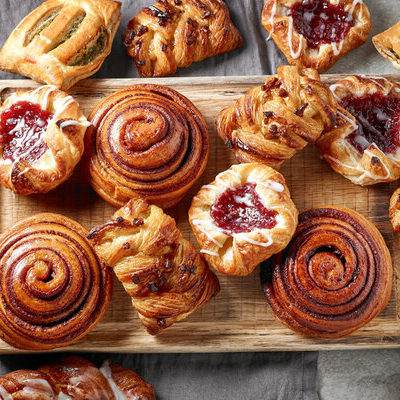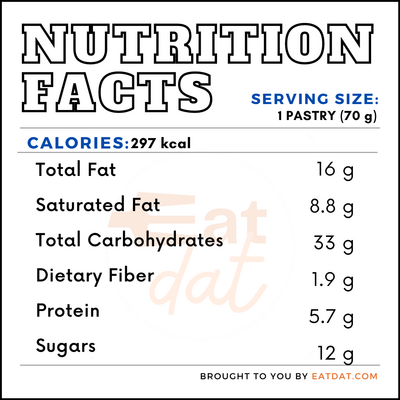
Pastry
What is Pastry?
Pastry is a sweet dough made by mixing water, fat, and flour. Pastries differ in taste and texture depending on the amount of fat utilized and the technique used to shape the dough. Six common types of pastry include: choux, phyllo, puff, samosa, shortcrust, and sable.
- However, pastry can also refer to baked goods filled with sweet or savory foods and fillings.
- In 2020, Americans bought more than two billion donuts and pastries.
The top ten most popular pastries in the world include:
- Croissant
- Doughnut
- Churros
- Borek
- Mooncake
- Éclair
- Cannoli
- Baklava
- Brioche
- Acma
Origin of pastries
This has its origin in the ancient world, as the Egyptians and Greeks used mixes of oil and flour in fruit pastries and honey cakes. The Romans also used a flour dough to cover the surface of meat while cooking. This mixture of oil, water, and flour prevented the meat’s exterior from burning and kept the inside moist. However, people did not eat this dough and, instead, threw it away after cooking. In medieval times, pastries that resembled the shortcrust variety that we know today began to appear.
In the 1700s, English bakers perfected several techniques for making this food. Claude Gelee, a French apprentice cook, created puff pastry in 1645 when his plan to make a rolled butter cake went awry. A manuscript dating back to 1692 contained the recipe for ‘puff paist’ which was written by Hannah Bisaker. As pastry became increasingly popular, different variations like Cornish pasty and Melton Mowbray pork pie began to spring up. Nowadays, a huge variety of pastries can be enjoyed across the globe.
Nutrition
A 70 g serving size of pastry contains:

While pastry contains dietary fat, there are some health benefits of this food:
- It can supply energy to the body and keep it warm.
- This food can help your body secrete vital hormones.
- It can protect body organs and assist in cell growth.
- This food can aid the body in absorbing nutrients.
Nonetheless, this food should be consumed in moderation due to its high level of calories. If consumed in excess, it can lead to weight gain and heart disease.
Commercial production
Pastries are made using a type of flour with low gluten content. During pastry production, the main objective is to decrease gluten formation to its lowest possible amount. For this reason, pastry chefs utilize solid fats rather than oils. Solid fats also coat flour better.
Furthermore, it is vital to make pastries in a cold area within the kitchen. The kitchen tools and ingredients are chilled before and during the baking process. Some people go to the extent of placing ice on their hands while making pastry dough. The low temperature prevents the formation of gluten.
An oven is a piece of primary equipment in the commercial production of this baked good. Convection ovens make use of forced air to increase production volume. The global market for pastries, cakes, and sweet pies was valued at $111.18 billion in 2017. The value is expected to rise with a growth rate of 4.3% between 2018 and 2023.
Application
When you make fresh pastries, allow them to cool down to room temperature before storage. If you don’t do this, the residual heat can make them soggy. To store these baked goods, place them inside a paper bag to maintain the crust’s quality. Then, make sure to seal the paper bag inside a plastic storage bag and eliminate any excess air. This way, the pastries can last for five days.
Pastries can last for two to three months in the freezer. Take care to use freezer storage bags that have been optimized for moisture-vapor resistance. To reheat your pastries, place them in the microwave for 30 seconds to 1 minute at a low setting.
Pastry recipes
People use this dough in both sweet and savory dishes. Some recipes to try include:
- Broccoli Cheddar Hand Pies
- Flaky Rhubarb Tart with Star Anise Custard
- Potato, Leek, and Pea Pot Pie
- Roast Sweet Potato & Onion Tart
- Savory Palmiers with Roasted Garlic and Rosemary
FDA regulation
The Food and Drug Administration does not explicitly regulate the production of pastries. However, the FDA provides recommended storage conditions for different types of pastry to avoid foodborne illnesses. The body also has standards of identity for various types of cereal flour and other related products. Flour is an integral component in making pastry. The FDA defines plain flour as food prepared by grinding and bottling cleaned wheat, other than durum wheat and red durum wheat.
References
“Pastries: Commercial Baking.” BAKERpedia, BAKERpedia, 10 Dec. 2018, bakerpedia.com/specialties/pastries/.
Conway, Published by Jan. “Dollar Sales of Bakery Products by Category U.S., 2020.” Statista, Statista, 18 Sept. 2020, www.statista.com/statistics/457119/us-dollar-sales-of-bakery-products-by-category/.
“CFR – Code of Federal Regulations Title 21.” accessdata.fda.gov, U.S Food & Drug Administration, 1 Apr. 2019, www.accessdata.fda.gov/scripts/cdrh/cfdocs/cfcfr/CFRSearch.cfm?CFRPart=137.
Sarah. “Different Types of Pastry and Their Uses.” www.bakingkneads.com, Baking Kneads, LLC, 3 Oct. 2017, www.bakingkneads.com/different-types-of-pastry-and-their-uses/.
